» Main Index

» Search This Site

» Submit Update

» Contact Us


|
|

|
Home > London >
E7 > Old Spotted Dog
Old Spotted Dog
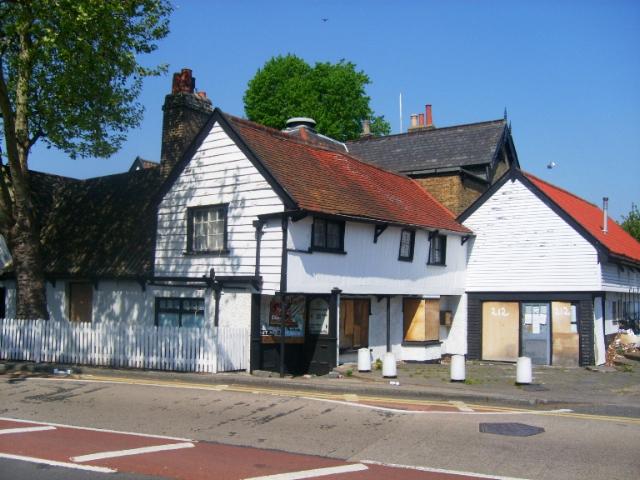
|
|
Picture source: Darkstar |
|
|
|
|
The Old Spotted Dog was situated
at 212 Upton Lane.
This
grade-II listed
pub dated back to 1602 when Forest Gate was forest and was named after royal
hunting dogs. Closed in 2004 and in 2009 a notice was posted by the Fire
Brigade saying it was a dangerous structure. |
|
Source: Colin Price |
|
|
|
|
|
Being close to Stratford School, this became my local a year or so before it
was legal! In 1966 the Victorian interior had been untouched for many years.
I remember the snug, with a system of screens between the bar staff and
customers.Part of this consisted of brass poles, holding elaborate carved
wooden and glass panels which could be rotated to place and order at the
bar. Somebody told me that Henry VIII liked to smoke his pipe here - The
ceiling was so thick with nicotine, I believed them. Soon after, an
extension was built to add a ‘steak house’. Lots of ‘character’ features hid
the newness of this extension, but of course the real character had been
destroyed in the ‘modernisation’. |
|
John (November 2011) |
|
|
|
|
|
Plans have been submitted to restore
this severely dilapidated disused pub and build a 68 room hotel next door.
Parts of grade-II listed The Spotted
Dog Inn in Forest Gate dating back to the 15th and 19th centuries could be
renovated to provide a bar, restaurant and coffee lounge if the bid goes
ahead. |
|
Colin Price (February 2020) |
|
|
|
Councillors approved plans to renovate
the 15th century Grade II-listed Old Spotted Dog pub in Upton Lane, Forest
Gate and build a 68 bedroom hotel next door at an online town hall meeting
on May 18. Developer Highpride Properties also wants to demolish 20th
century additions to the venue and provide a bar, restaurant, lounge,
meeting room and garden. |
|
Colin Price (May 2020) |
|
|
|
|
|
Listed
building details: |
II Timber-framed building, later a
public house, dating in part to the late-C15 or early-C16 with subsequent
phases of the late-Georgian, Victorian and post-WWII periods.
EXTERIOR: The central range of the main frontage, a timber-framed two-bay
hall with open crown post roof, is the earliest part of the building and
dates to the late-C15 or early-C16. There are two doors, both with C19
joinery, leading into the building here and the tiled roof eaves come right
down to their architraves; there is a brick stack to the right of this range
too. This early core is flanked by two-storey cross-wings, also
timber-framed, that to the right contemporary with the central hall and that
to the left dating from slightly later. Both have jettied, weather-boarded
upper storeys with horizontal sliding sashes in the gables and rough-cast
rendered ground floors; both jetties rest on later supports, a brick return
wall to the left-hand wing and iron posts to the right on the eastern
return. The cross-wing to the left has a four-centre arched door and a large
window with marginal glazing on the ground floor, that to the right just a
window opening, with an entrance on the canted corner to the return. This
return, facing east, has a late-C19 bay window on the ground floor and more
sashes on the first. Further along the return is an extension,
weather-boarded in keeping with the original, but dates to 1968 and lacks
special interest. Above it the gables of the Victorian part of the building
are visible, complete with bargeboards and finials. The return to the west
has two Edwardian porches and a brick chimney flue, also of a C19 or later
date, as well as further sash windows. Beyond is the addition of the
late-Georgian period, possibly a house originally, a stock brick range with
a slate hipped roof, gauged brick arches to the sash windows and brick
pilasters. The windows to the right have been altered or bricked in and the
door altered too; it once had a canopy and porch. A two-storey extension
with metal casements dating to the second half of the C20 abuts this
building to the north. Alongside this are a single-storey 1980s function
room and a garage. None of these three parts of the building have special
interest. On the contrary, the Victorian sections, visible above ground
floor and identifiable through their stock brick elevations with red brick
dressings, timber sash windows, decorative bargeboards to the gables and
slate roofs, do contribute to the interest of the building.
INTERIOR: In the single room of the central hall, the roof is
partly-exposed. This is a crown post with lateral head braces and the timber
is hand-sawn but without particular embellishment in the form of chamfers,
stops, or other carving. To the right, set under the tie beam, is an
inserted stack with hearth, timber bressummer, iron grate and oven. To the
left, the wall has a later opening in its upper part looking through to the
roof trusses of the cross-wing. A serving bar and back bar along the back of
this room appear Victorian in date, as is some of the other joinery; other
elements are modern. The floor is paved with York flagstones. The cross-wing
to the left has a crown post roof with studs and braces to the walls. The
ground floor ceiling is supported by Victorian iron colonettes and contains
later fireplaces and panelling. The cross-wing to the right has a tie beam
and moulded wall plate but no other elements of the roof are visible. There
is a simple late-Georgian timber fireplace in the upper room in this wing,
some plain partitioning of the same date in another and a sash window in a
third room which may indicate the old end wall of the range. On the ground
floor the principal beams in the ceiling are moulded and there are various
items of panelling and other joinery including fireplaces dating to no later
than the C19. Inside the later sections to the rear, both late-Georgian and
Victorian, there are no fireplaces, bar counters or staircases of historic
interest as the building was refurbished in the second half of the C20 and
much of the fabric dates to this period.
The interior of the Victorian section of the pub is characterised by a
medley of timber-framed structures including one section that appears to be
a jettied external wall of a timber-framed building, but that does not
relate in its location to the late-medieval parts of the building. Some of
the timbers are old, others newer, and most are painted with brown paint. A
photograph of 1967 shows a gap in the external wall in this area and the
timbers do not appear to be present; photos from 1968 show the interior as
it is now. It is likely that most of the internal fabric in this part of the
pub was assembled from timbers, perhaps salvaged from elsewhere, in the
refurbishment of 1968. It lacks special interest.
HISTORY: Originally a house, the Spotted Dog was later converted to a pub,
possibly in the early-C19 when it appears on Clayton's map of 1821 labelled
'The Dog'. On an earlier map, by Chapman and Andre of 1777, it is not given
a name, despite other public houses nearby being marked, so it was
presumably a private abode at that time. A range (which appears domestic and
may have originally served as the publican's house) was added in the
late-Georgian period, before 1840.
In 1839 the proprietor was a William Vause whose family held the lease until
1917. Vause advertised his business to Londoners in search of resort: a C19
poster survives showing the building and boasting of its 'spacious dining
room and billiards' and 'good accommodation for cricket and other field
sports'. The billiards room may have been a modification of the
late-Georgian range; it appears on later photographs with a timber lantern
on the roof, which may have lit the games room. At that time the Spotted Dog
overlooked playing fields to the west and gardens to the north. Under the
Vauses, the old pub was enlarged further, probably in the decades between
1867 and 1896 when its footprint alters on the Ordnance Survey maps.
The area around the Spotted Dog changed dramatically in the late-C19 and
early-C20, and by the outbreak of WWI the claim on the Victorian poster that
the pub was located in 'one of the most pleasant parts of Essex' was no
longer true, not least because from 1888 the Spotted Dog has been in the
County Borough of West Ham. Terraced houses lined nearby streets, the
cricket field became the home of Clapton FC (the club remains there to this
day) and the pub sold off some of its gardens. The pace of change
accelerated in the second half of the C20 and further additions and
alterations were made to the building, including major internal
refurbishment and extension in 1968, before it fell out of use at the end of
the C20.
REASONS FOR DESIGNATION: The Spotted Dog public house is listed at Grade II
for the following principal reasons: * a well-surviving, if simply
constructed, late-C15 or early-C16 house comprising central hall and
flanking two-storey cross wings, these with weatherboarded jetties; *
interesting interior including exposed timbers, hearth with bressummer,
other fireplaces and historic joinery including a Victorian bar and back
bar; * particular poignancy as a rare-surviving late-medieval building in
this area, evoking the rural character that could be enjoyed here until the
middle of the C19, when this part of old Essex was lost to the expanding
capital. |
|
|
|
|
|
Do you have any anecdotes, historical information, updates or photos of this pub? Become a contributor by submitting them here. Like this site? Follow us on

|
|
Contacts |
|
You can also make email contact with other ex-customers and landlords of this pub by adding your details to this page. |
| Name |
Dates |
Comments |
|
Mandi Stepniewska |
1960 |
I need to know what the hell is happening to this major part of our
history, that I have loved all my life! I cant even begin to express
the grief that I feel each time i pass the Spotted Dog... |
|
Don Thompson |
1950 |
My dad's local all his life. |
|
Jason Taylor |
1970-1983 |
I used to go here with my grandad; he
drank there all his life.Its such a shame its been allowed to go to
ruin, I have fond memories of the pub. My nan and grandad use to run
Jones greengrocers in St Georges Road, Lena and Alf. |
|
Jan Boyce |
1968-1990 |
This pub is gradually crumbling away. A petition has been set up to try
to get it some protection. The petition url is
https://submissions.epetitions.direct.gov.uk/petitions/37179.
We need atleast 1000 signatures. |
|
Lynda Bold |
1973-1976 |
Manager Schooner Inns |
| |
|
Other Photos |
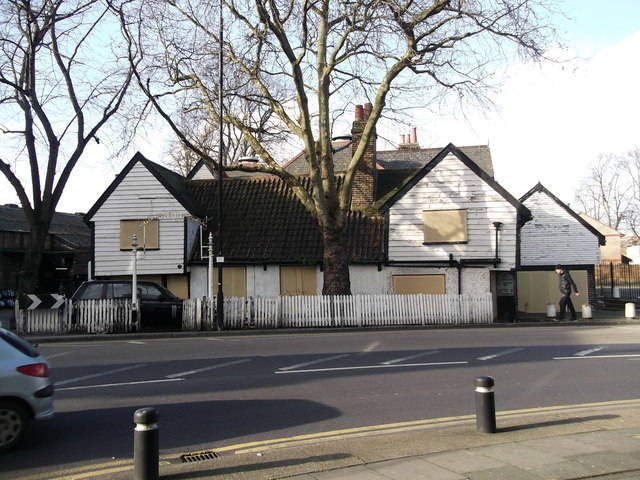 |
|
Date of photo: 2014 |
Picture source: Colin Price |
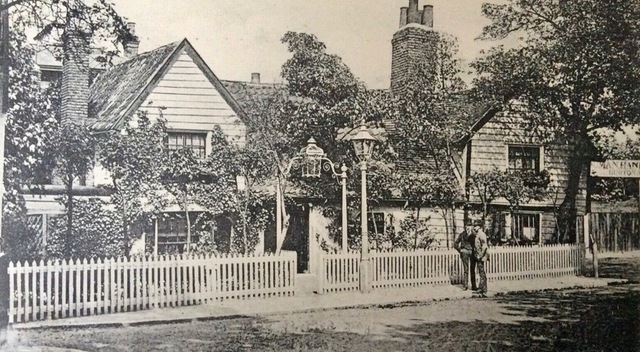 |
|
|
Picture source: Hania Franek |
|
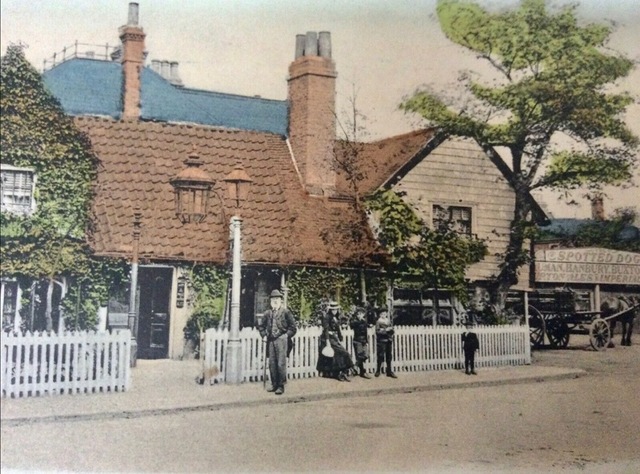
|
|
|
Picture source: Hania Franek |
|
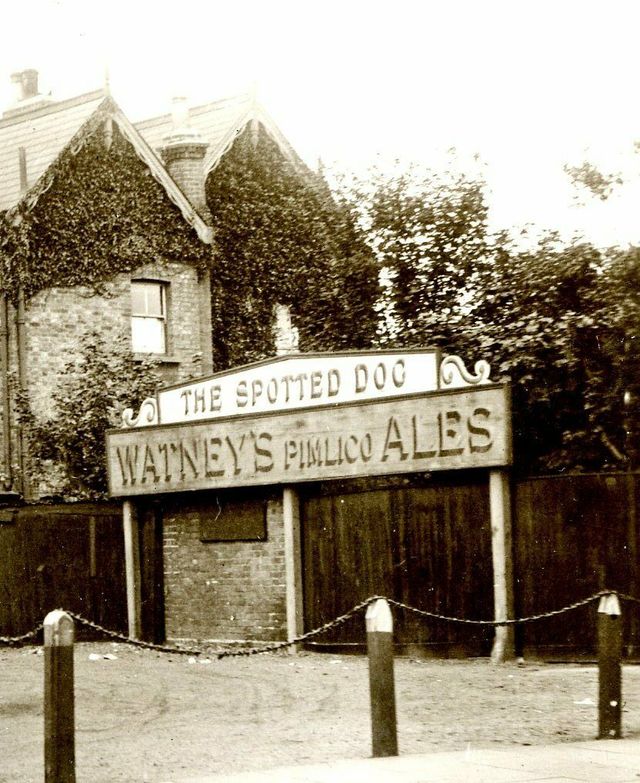
|
| |
|
|